NavSource Online: Submarine Photo Archive
Skate / F-4 (SS-23)

![]()
![]()
![]()
F Class Submarine: Laid down, as Skate, 21 August 1909, at Moran Bros, Seattle, WA.; Renamed F-4, 17 November 1911; Launched, 6 January 1912; Commissioned USS F-4, 3 May 1913; Sunk by mechanical failure, foundered of Honolulu, HI, 25 March 1915; Raised, 29 August 1915; Struck from the Naval Register, 31 August 1915; Final Disposition, in 1940 the remains of F-4 (SS-23) were buried as fill in a trench off the Submarine Base, Pearl Harbor.
Partial data submitted by Yves Hubert. Specifications: Displacement, surfaced 330 t., submerged 400 t.; Length 142' 7"; Beam 15' 5"; Draft 12' 2"; Speed, surfaced 13.5 kts, submerged 11.5 kts; Depth Limit 200'; Complement 1 Officer 21 Enlisted; Armament, four 18" torpedo tubes, four torpedoes; Propulsion, diesel electric, Craig Shipbuilding Co., engines, 800 hp, Fuel Capacity 11,500 gal., Electro Dynamic Co. motors, 620 hp, Battery Cells 120, twin propellers.
| Click On Image For Full Size | Size | Image Description | Source | |||
|---|---|---|---|---|---|---|
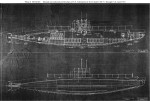 | 210k | U.S. submarines (SS-20) through (SS-23). General plans prepared by the Fore River Shipbuilding Company, Quincy, Massachusetts, 18 June 1910. This sheet features inboard and outboard profile drawings. These submarines were constructed by the Union Iron Works, San Francisco, California. Initially named Carp (SS-20), Barracuda (SS-21), Pickerel (SS-22) and Skate (SS-23), they were renamed F-1 (SS-20) through F-4 (SS-23) in November 1911, while under construction. The original plan is in Record Group 19 at the U.S. National Archives. | USNHC photograph # NH 84383. Courtesy of Donald M. McPherson, 1976. | |||
 | 201k | U.S. Submarines (SS-20) through (SS-23). General plans prepared by the Fore River Shipbuilding Company, Quincy, Massachusetts, 18 June 1910. This sheet features a table of dimensions, deck plans and hull section drawings. These submarines were constructed by the Union Iron Works, San Francisco, California. Initially named Carp (SS-20), Barracuda (SS-21), Pickerel (SS-22) and Skate (SS-23), they were renamed F-1 (SS-20) through F-4 (SS-23) in November 1911, while under construction. The original plan is in Record Group 19 at the U.S. National Archives. | USNHC photograph # NH 84382. Courtesy of Donald M. McPherson, 1976. | |||
 | 24k | In the F class (SS-20 - 23) the conning tower is shown in dashed vertical lines between the two periscopes. This class & the E class (SS-24 - 25) introduced bow planes into Electric Boat practice. | Drawing by Jim Christley. Photo & text courtesy of U.S. Submarines Through 1945, An Illustrated Design History by Norman Friedman. Naval Institute Press. | |||
 |
409k | First Submarine Launch in the Northwest, the F-3 (SS-22), 6 January 1912. In spite of the austere dress, a national ensign and union jack only, the launch of F-3 (SS-22) & F-4 (SS-23) that cold day occasioned enthusiastic celebration along the entire waterfront. | Photo courtesy of Seattle Post Intelligencer. 7 January 1912, from the Beneath the Surface: World War I Submarines Built in Seattle and Vancouver by Bill Lightfoot. | |||
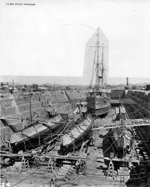 |
994k | F class (SS-20 - 23) submarines and their tender are in DD#2 at Mare Island on 21 January 1913. Left to right: F-3 (SS-22), F-2 (SS-21), F-1 (SS-20) and Alert (AS-4) in the background. | USN photo / MINSY # 01211913-01 courtesy of Darryl L. Baker. | |||
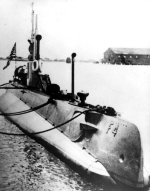 |
78k | F-4 (SS-23), photographed in 1913-15. | USN photo # NH 74736, from the collections of the US Naval Historical Center. Courtesy of Donald M. McPherson, 1972. | |||
 |
81k | F-4 (SS-23), at Honolulu in 1914 along with (from front to back): F-2 (SS-21), F-3 (SS-22) and F-1 (SS-20). The US Army Transport Dix is in the background. Note the "fish" flags and 13-star "boat" ensigns flown by these submarines. Photographed by Noggle. | USN photo # NH 63259, from the collections of the US Naval Historical Center. | |||
 |
124k | Tender Alert (AS-4) at Long Beach CA., circa 1914 with several subs alongside. The one next to the Alert is not identifiable, the F-3 (SS-22) second inboard, third boat can't be identified due to flag & F-4 (SS-23) is outboard. | Photo courtesy of Vernon P. Maxson, Jr. LCDR,USNR-R-RETIRED (SS) (former crew member, PARGO-SS-264) & Ric Hedman. | |||
 |
478k | F-4 (SS-23) on West Point Spit. Most Seattle to Port Townsend traffic avoids West Point. F-4 did not, but no damage was done (except to egos)? The light keeper provided a wooden ladder to facilitate communication. | Photo courtesy of Seattle Post Intelligencer. 14 March 1913, from Beneath the Surface: World War I Submarines Built in Seattle and Vancouver by Bill Lightfoot. | |||
 |
408k | F-4 (SS-23) on Port Townsend Bay. The canvass dodger has been rigged on the collapsible bridge for these surface trials. The submarine bell rides proudly on the fore deck indicating that F-4 has not yet engaged Quincy Wharf. | Photo courtesy of Pacific Marine Review July 1913, from Beneath the Surface: World War I Submarines Built in Seattle and Vancouver by Bill Lightfoot. | |||
 |
84k | F-4 (SS-23) at left at anchor in Honolulu, HI. with F-1 (SS-20), center, and F-2 (SS-21) outboard, moored together. Date unknown. | Courtesy of MMCM (SS) Greg Peterman USN Retired. Text i.d. from "The Romance of A Submarine" by G. Gibbard Jackson & submitted by Robert Hurst. | |||
| Loss & Salvage |
||||||
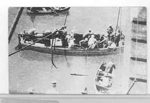 |
296k | Four photo postcards showing scenes of the US Navy sailors along with their deep sea diver(s) searching for lost submarine F-4 (SS-23) off the coast of Honolulu, Hawaii on 25 March 1915. | Photo & text courtesy of Tommy Trampp. | |||
 |
1.01k | CITY STIRRED WITH DEEP SYMPATHY FOR MEN OF THE LOST SUMBARINE | Image and text provided by University of Hawaii at Manoa; Honolulu, HI. Photo from Honolulu Star-Bulletin. (Honolulu [Oahu, Hawaii) 1912-current, 26 March 1915, 2:30 Edition, Image 3, courtesy of chroniclingamerica.loc.gov. |
|||
 |
1.03k | HUMAN INGENUITY IS TAXED TO GET SAFE SUBMARINE F-4 STILL LOST; SEARCH KEPT UP AND HOPES FOR 21 MEN ARE HIGHER | Image and text provided by University of Hawaii at Manoa; Honolulu, HI. Photo & text by Honolulu Star-Bulletin. (Honolulu [Oahu, Hawaii) 1912-current, 26 March 1915, 2:30 Edition, Images 1 & 2, courtesy of chroniclingamerica.loc.gov. |
|||
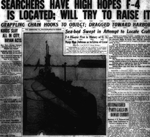 |
NR | SEARCHERS HAVE HIGH HOPES F-4 (SS-23) IS LOCATED; WILL TRY TO RAISE IT. THE SUBMARINE F-4 PHOTOGRAPHED IN HARBOR | Image and text provided by University of Hawaii at Manoa; Honolulu, HI. Photo & text by Honolulu Star-Bulletin. (Honolulu [Oahu, Hawaii) 1912-current, 26 March 1915, 3:30 Edition, Image 1, courtesy of chroniclingamerica.loc.gov. |
|||
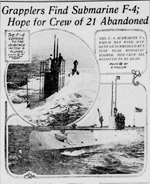 |
NR | Grapplers Find Submarine F-4 (SS-23). Hope for Crew of 21 Abandoned. |
Image and text provided by Library of Congress, Washington, DC. Photo from the New-York Tribune. (New York [N.Y.]) 1866-1924, 27 March 1915, Image 1, courtesy of chroniclingamerica.loc.gov. | |||
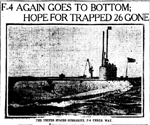 |
923k | F-4 (SS-23) AGAIN GOES TO BOTTOM; HOPE FOR TRAPPED 26 GONE | Image and text provided by Library of Congress, Washington, DC. Photo & text by The Washington Herald. (Washington, D.C.) 1906-1939, 28 March 1915, Image 1, courtesy of chroniclingamerica.loc.gov. | |||
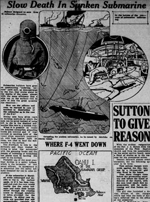 |
1.17k | Slow Death In Sunken Submarine F-4 (SS-23). | Image and text provided by Washington State Library; Olympia, WA. Photo & text by The Tacoma Times. (Tacoma, Wash.) 1903-1949, 29 March 1915, Image 7, courtesy of chroniclingamerica.loc.gov. |
|||
 |
1.12 | Fighting Hard against Time, Men Work to Find Buried Comrades | Image and text provided by University of Hawaii at Manoa; Honolulu, HI. Photo from Honolulu Star-Bulletin. (Honolulu [Oahu, Hawaii) 1912-current, 29 March 1915, 3:30 Edition, Image 3, courtesy of chroniclingamerica.loc.gov. |
|||
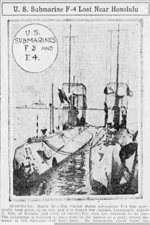 0802210 | NR | U. S. Submarine F-4 (SS-23) Lost Near Honolulu Submarines F-3 (SS-22) & F-4. The submarine is believed to have sunk in the harbor at a point where the water is 120 fantoms, 720 feet deep. No submarine could resist the water pressure at such depth without crumpling. |
Image and text provided by Oklahoma Historical Society. Photo from Tulsa Daily World. [volume] (Tulsa, Indian Territory [Okla.]) 1905-1919, 30 March 1915, MORNING EDITION, Image 1, via chroniclingamerica.loc.gov |
|||
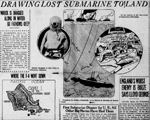 |
663k | DRAWING LOST SUBMARINE TO LAND WRECK IS DRAGGED ALONG IN WATER 60 FATHOMS DEEP | Image and text provided by University of Oregon Libraries; Eugene, OR. Photo & text by Medford Mail Tribune. (Medford, Or.) 1909-1989, 30 March 1915, SECOND EDITION, Image 1, courtesy of chroniclingamerica.loc.gov. |
|||
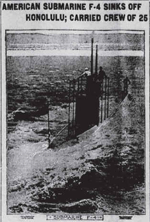 |
708k | AMERICAN SUBMARINE F-4 (SS-23) SINKS OFF HONOLULU; CARRIED CREW OF 25. Great disappointment was felt here when the announcement was made that the searchers for the missing submarine F-4 had thus far failed to locate her in spite of previous statements she had been found and partly raised. The truth of the situation was revealed by Diver Agraz of the submarine service, who went down 215 feet only to find that the dredging hook was fast to a discarded anchor and not to the lost boat, as had been believed for two hours. |
Image provided by: Ohio Historical Society, Columbus, OH. Photo & text by The Democratic Banner. (Mt. Vernon, Ohio) 1898-192?, 30 March 1915, Image 1, courtesy of chroniclingamerica.loc.gov. |
|||
 |
587k | HEAVY HAWSERS NEEDED TO DRAG SUBMARINE INTO SHALLOWER WATER The F-4 (SS-23) as she appeared while under way in a trial run. |
Image and text provided by University of Oregon, Knight Library; Eugene, OR. Photo & text by Medford Mail Tribune.(Medford, Or.) 1909-1989, 31 March 1915, SECOND EDITION, Image 1, courtesy of chroniclingamerica.loc.gov. | |||
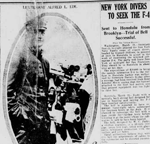 |
993k | NEW YORK DIVERS TO SEEK THE F-4 (SS-23) Sent to Honolulu from Brooklyn - Trial of Bell Successful |
Image and text provided by Library of Congress, Washington, DC. Photo & text by New-York Tribune.(New York [N.Y.]) 1866-1924, 1 April 1915, Image 16, courtesy of chroniclingamerica.loc.gov. | |||
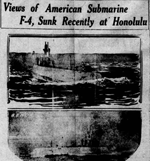 |
614k | Views of American Submarine F-4 (SS-23) Sunk Recently at Honolulu. | Image and text provided by University of Oregon, Knight Library; Eugene, OR. Photo & text by The Evening Herald. (Klamath Falls, Or.) 1906-1942, 02 April 1915, Image 1, courtesy of chroniclingamerica.loc.gov. | |||
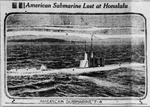 |
478k | American Submarine Lost at Honululu. | Image and text provided by University of Oregon Libraries; Eugene, OR. Photo & text by Daily Capital Journal. (Salem, Or.) 1903-1919, 05 April 1915, Image 3, courtesy of chroniclingamerica.loc.gov. | |||
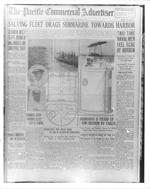 |
169k | Newspaper clipping of the loss of the F-4 (SS-23). | USN photo courtesy of Scott Koen & ussnewyork.com. | |||
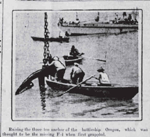 | 601k | Raising the three ton anchor of the battleship Oregon (BB-03) which was thought to be the missing F-4 (SS-23) when first grappled. | Image and text provided by University of Oregon, Knight Library; Eugene, OR. Photo from Medford Mail Tribune. (Medford, Or.) 1909-1989, 08 April 1915, SECOND EDITION, Image 1, via chroniclingamerica.loc.gov. |
|||
 |
808k | The cause of the disaster to the F-4 (SS-23) in Hawaiian waters was the collapse of the inner shell of the oil tanks in the bow after the hull was crushed on a coral reef. | Image and text provided by Library of Congress, Washington, DC. Photo & text by New-York Tribune.(New York [N.Y.]) 1866-1924, 11 April 1915, Image 6, courtesy of chroniclingamerica.loc.gov. |
|||
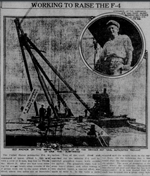 0802364 |
NR | WORKING TO RAISE THE F-4 (SS-23). OLD ANCHOR ON THE BARGE WAS PICKED UP BY THE DREDGE AND NAVAL AUTHORITIES THOUGHT IT WAS THE SUBMARINE The United States submarine F-4, in command of Lieut. Alfred L. Ede, with a crew of 25 men, was lost on Thursday, March 25. After she had been missing for several hours other vessels of the F group went out to the point where it dived, about two miles out of Honolulu harbor. Two of the craft dived and searched for the missing F-4, and by nightfall grapplers began work outside the harbor. The grapplers made fast to some heavy object, and after towing it into shallow water, a hurried effort was made to raise it. In the haste a cable snapped and the weight sank to the harbor floor. On the following day it was found that the submerged object was an old anchor. The work of dredging at the point where the submarine disappeared was started all over and thus far has been unsuccessful. It is now feared that the craft has dropped into a great coral hole. |
Image and text provided by University of Alabama Libraries, Tuscaloosa, AL. Photo & text by The Birmingham Age-Herald. [volume] (Birmingham, Ala.) 1902-1950, 13 April 1915, Image 1, via chroniclingamerica.loc.gov. | |||
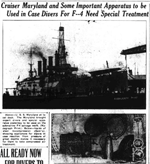 |
1.04k | Cruiser Maryland (ACR-8) and Some Important Apparatus to be Used in Case Divers For F-4 (SS-23) Need Special Treatment | Image and text provided by University of Hawaii at Manoa; Honolulu, HI. Photo & text by Honolulu Star-Bulletin. (Honolulu [Oahu, Hawaii) 1912-current, 13 April 1915, 3:30 Edition, Image 1, courtesy of chroniclingamerica.loc.gov. |
|||
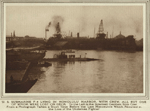 |
550k | Diver "Jack" Adrez going down to search for the F-4 (SS-23), when he had made the record dive of 215 feet. In the foreground on the government dredge brought to the scene for the purpose of raising the submarine, are the crews of the other United States submarines in the Honolulu Harbor. U.S.SUBMARINE F-4 LYING IN HONOLULU HARBOR. WITH CREW, ALL BUT ONE OF WHOM WERE LOST ON DECK. To the Left is the interned German Ship Gier, From a Photograph Taken a Short time Before the Last Manoeuvre Which Resulted in the Loss of the Undersea Fighter |
Photo by Central News, courtesy of memory.loc.gov. Partial text from The New York Times, 18 April 1915. Page 2. |
|||
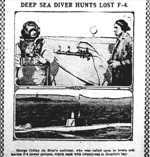 |
609k | DEEP SEA DIVER HUNTS LOST F-4 (SS-23) George Crilley (In diver's uniform), who was called upon to locate F-4 (lower picture), which sank with twenty-one in Honolulu bay. | Image and text provided by Library of Congress, Washington, DC. Photo & text by The Washington Herald. (Washington, D.C.) 1906-1939, 18 April 1915, PICTORIAL SECTION, Image 28, courtesy of chroniclingamerica.loc.gov. | |||
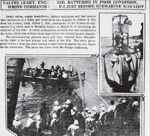 |
671k | VALVES LEAKY, ENGINE BAD, BATTERIES IN POOR CONDITION, WROTE COMMANDER OF F-4 (SS-23) JUST BEFORE SUBMARINE WAS LOST. Leaky valves, engine breakdowns, battery and bad motors were in a letter just received in Los Angeles by Allison S. Ede from his brother, Lieut. Alfred L. Ede, of the submarine F-4, which sank in Honolulu harbor on March 25, in describing the condition of the boat. A veiled premonition of death was also contained in the letter, which was written three days before they met disaster. The accompanying pictures have just been received from Honolulu. At the right is the last picture ever taken of the F-4. The other photograph shows a deep sea diver leaving a small boat to search the sea depths for the submarine. The photo was taken from the dredge California. |
Image and text provided by Ohio Historical Society, Columbus, OH. Photo & text by Perrysburg Journal. (Perrysburg, Wood Co., O. [Ohio]) 186?-1965, 22 April 1915, Image 6, courtesy of chroniclingamerica.loc.gov. |
|||
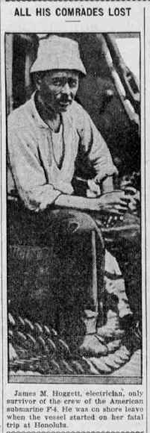 |
763k | ALL HIS COMRADES LOST James M. Hoggett, electrician, only survivor of the crew of the American submarine F-4 (SS-23). He was on shore leave when the vessel started on her fatal trip at Honolulu. |
Image and text provided by University of Nebraska-Lincoln Libraries, Lincoln, NE. Photo & text by Dakota County Herald. (Dakota City, Neb.) 1891-1965, 29 April 1915, Image 3, courtesy of chroniclingamerica.loc.gov. | |||
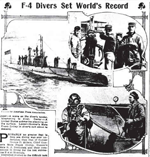 |
744k | F-4 (SS-23) Divers Set World's Record. | Image and text provided by Library of Congress, Washington, DC. Photo & text by The Washington Herald. (Washington, D.C.) 1906-1939, 02 May 1915, PICTORIAL SECTION, Image 31, courtesy of chroniclingamerica.loc.gov. |
|||
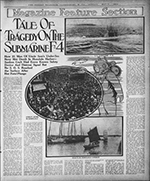 |
1.47k | How 21 Men Of Uncle Sam's Under-Sea Navy Met Death In Honolulu Harbor? Sunken Craft Had Every Known Safety Device And Distress Signal But No S. O. S. Reached the Surface After Her Fatal Plunge. | Image and text provided by West Virginia University. Photo & text by The Sunday Telegram. (Clarksburg, W. Va.) 1914-1927, 09 May 1915, Image 27, courtesy of chroniclingamerica.loc.gov via Ric Hednan . | |||
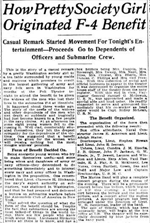 |
957k | How Pretty Society Girl Originated F-4 (SS-23) Benefit. | Image and text provided by Library of Congress, Washington, DC. Photo & text by The Washington Times. (Washington [D.C.] 1902-1939, 16 May 1919, FINAL EDITION, Image 15, via chroniclingamerica.loc.gov. | |||
 0802360 |
339k | Model of F-4 (SS-23) aboard the salvage operation's diving barge. Note the hard hat helmets in the background. | Photo courtesy of Darryl L. Baker. | |||
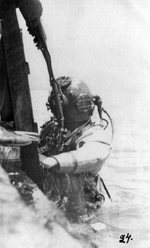 0802360a |
264k | Hard hat diver. This diving rig is definitely not the famous USN Mk V diving helmet and dress. The Mk V was not adopted until 1916, well after the salvage operation for the F-4 (SS-23) was wrapped up. However, the F-4 operation proved to be a crucible under which Chief Gunner George Stillson tested various concepts that led up to the Mk V. Various different configurations of Morse and Schrader commercial helmets were tried and were given official USN Mark numbers, along with modifications that Stillson and his staff tried to increase safety and functionality. This particular helmet is one of those earlier iterations, in this case a Schrader Mk IV. One of the variations applied to this Mk IV was a circular telephone transceiver recess on the lower left rear side of the helmet below the air inlet. Prior to the official adoption of the Mk V in 1916, the Navy obtained the majority of its diving gear from the two companies listed above. Once the Navy standardized on the Mk V, four companies would eventually produce them in huge numbers: A.J. Morse and Sons, Boston, MA Miller-Dunn Company, Miami, FL A.Schrader's Son, Inc., Brooklyn, NY Diving Equipment and Salvage Corp (DESCO), Milwaukee, WI It was a good move. It allowed the Navy to standardize on parts and logistics, and on training. The Mk V was perhaps the best hard hat diving dress in the world for seven decades. |
Text courtesy of David Johnston (USN, retired) Photo courtesy of Darryl L. Baker. |
|||
 0802360b |
303k | Diver being tended to aboard diving float. | Photo courtesy of Darryl L. Baker. | |||
 0802360c |
275k | One of the windlasses used to lift the F-4 (SS-23). They were installed on a civilian mud scow. | Photo courtesy of Darryl L. Baker. | |||
 0802360d |
548k | Two photo PDF of deep water operation vessels - Two 104' X 36' mud scows, diving (coal) barge, dredge California without boom & bucket, etc. The scows' steam-driven pumps are visible. | Photos courtesy of Darryl L. Baker. | |||
 |
388k | Diver in water for 5 hours seeking submarine F-4 (SS-23). | Image provided by: Penn State University Libraries; University Park, PA. Photo & text by The Evening Public Ledger. (Philadelphia [Pa.]) 1914-1942, 1 June 1915, courtesy of chroniclingamerica.loc.gov. |
|||
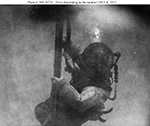 |
132k | Diver descending to the sunken submarine. Photographed 90 feet below the surface. | Photo courtesy of Donald M. McPherson, 1972. USNHC photograph # NH 74731 via Robert Hurst. | |||
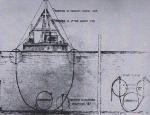 |
141k | Naval Constructor Furer developed this method for recovery of the F-4 (SS-23) from the ocean floor off Honolulu. Six large pontoons were constructed at Mare Island for this project and freighted to Hawaii on the deck of the armored cruiser Maryland (ACR-8). | Photo & text courtesy of Beneath the Surface: World War I Submarines Built in Seattle and Vancouver by Bill Lightfoot. | |||
 0802358 |
335k | Photo of the New York Navy Yard's recompression chamber used during salvage of F-4 (SS-23). The chamber was shipped to Mare Island and then put aboard Maryland (ACR-8) for the trip to Pearl Harbor. | Photo courtesy of Darryl L. Baker. | |||
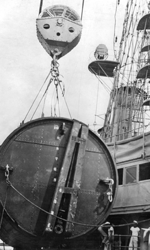 0802358a |
266k | Photo of one of the salvage pontoons being lifted aboard Maryland (ACR-8) at Mare Island Navy Yard. | Photo courtesy of Darryl L. Baker. | |||
 0802358b |
335k | View of the stern of Maryland (ACR-8) with salvage pontoons loaded at Mare Island Navy Yard. Maryland was in dry dock at the time. | Photo courtesy of Darryl L. Baker. | |||
 0802358c |
330k | View of salvage pontoons on the stern of Maryland (ACR-8) at Pearl Harbor. | Photo courtesy of Darryl L. Baker. | |||
 0802358d |
229k | Salvage pontoons being unloaded at Pearl Harbor by their 150-ton floating crane. | Photo courtesy of Darryl L. Baker. | |||
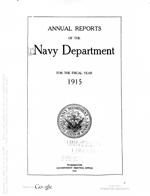 0802358e |
1.91k | Attached is the Navy's 4 page PDF report on the salvage operation found in the Navy's Report to Congress in 1915, pages 66-68. | Photo courtesy of Darryl L. Baker. | |||
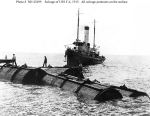 |
102k | Salvage of F-4 (SS-23). Valve manifold and hose leads to submerged pontoons, on board a salvage vessel off Honolulu, circa 29 August 1915. Halftone photograph, copied from "Transactions of the Society of Naval Architects and Marine Engineers", Volume 24, 1916, Figure 11. The tug is probably Navajo. | USN photo # NH 43499, from the collections of the US Naval Historical Center. | |||
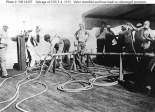 |
104k | Salvage of F-4 (SS-23), April-August 1915. Valve manifold and hose leads to submerged pontoons, on board a salvage vessel off Honolulu, Hawaii, probably in August 1915. This equipment was devised by Naval Constructor Julius A. Furer. Halftone photograph, copied from "Transactions of the Society of Naval Architects and Marine Engineers", Volume 24, 1916, Figure 11. The tug in the left distance is probably Navajo. | USN photo # NH 43497, from the collections of the US Naval Historical Center. | |||
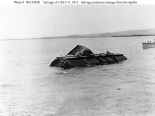 |
70k | Salvage of F-4 (SS-23), April-August 1915. Bow salvage pontoons emerging from the depths, off Honolulu, Hawaii, circa 29 August 1915, during the final lifting of the sunken submarine. The salvage equipment was devised by Naval Constructor Julius A. Furer. Halftone photograph, copied from "Transactions of the Society of Naval Architects and Marine Engineers", Volume 24, 1916, Figure 12. | USN photo # NH 43498, from the collections of the US Naval Historical Center. | |||
 0802361 |
284k | Towing F-4 (SS-23) to dry dock. | Photo courtesy of Darryl L. Baker. | |||
 0802351a | 587k | The United States Submarine F-4 (SS-23) Which Sank off Honolulu with the Loss of All Onboard towed into Honolulu harbor. Supported Six Feet Below the Surface by Huge Pontoons. The Sailors Have Hoisted the Stars and Stripes Lashed to an Oar. | Insert photo courtesy of Darryl L. Baker. USN photo by Underwood & Underwood. Text courtesy of N.Y. Times, 19 September 1915, Page 1, courtesy of memory.loc.gov. |
|||
 |
88k | This edited photo illustrates how the F-4 (SS-23) was moved from deep water into the dry dock after being raised from a record setting depth of 320 feet, a salvage record that held for 54 years. | Photo & text courtesy of Beneath the Surface: World War I Submarines Built in Seattle and Vancouver by Bill Lightfoot. Photo from Kerrick, Military & Naval America. | |||
 |
86k | Salvage of F-4 (SS-23), circa 29 August 1915. Salvage pontoons on the surface, off Honolulu, after the final lifting of the sunken submarine in preparation for towing her into Honolulu harbor. Note wooden protective sheathing around the pontoons. Salvage equipment was devised by Naval Constructor Julius A. Furer. The tug is probably Navajo. | USN photo # NH 74732, from the collections of the US Naval Historical Center. Photo courtesy of Donald M. McPherson, 1972. |
|||
 |
41k | Pontoons used to raise the F-4 (SS-23). | Photo courtesy of Jack Treutle (of blessed memory). | |||
 |
31k | Harbor scene as the pontoons used to raise the F-4 (SS-23) pass by. | Photo courtesy of Jack Treutle (of blessed memory). | |||
 |
622k | Pontoons With Recovered Submarine F-4 (SS-23) Underneath Crossing Honolulu Harbor In Tow | Image and text provided by University of Hawaii at Manoa; Honolulu, HI. Photo & text by The Hawaiian Gazette. (Honolulu [Oahu, Hawaii]) 1865-1918, 31 August 1915, Image 1, courtesy of chroniclingamerica.loc.gov. |
|||
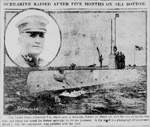 |
942k | SUBMARINE RAISED AFTER FIVE MONTHS ON OCEAN BOTTOM | Image and text provided by Library of Congress, Washington, DC. Photo & text by New-York Tribune.(New York [N.Y.]) 1866-1924, 31 August 1915, Image 3, courtesy of chroniclingamerica.loc.gov. | |||
 |
829k | SEARCHERS IN HULL OF F-4 (SS-23) FIND BODIES; ONE SOON IDENTIFIED Gaping Hole In Side of Submarine Shown as Battered Vessel Lies on Drydock | Image and text provided by University of Hawaii at Manoa; Honolulu, HI. Photo & text by Honolulu Star-Bulletin. (Honolulu [Oahu, Hawaii) 1912-current, 31 August 1915, 2:30 Edition, Image 1, courtesy of chroniclingamerica.loc.gov. |
|||
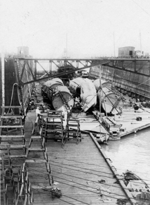 |
248k | The salvaged F-4 (SS-23) sits in a floating dry dock in Pearl Harbor in August 1915. Note: Pontoons beside her were constructed at Mare Island Navy Yard. |
USN photo courtesy of Darryl L. Baker. | |||
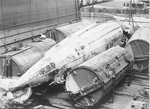 |
729k | The ripped F-4 (SS-23) lies in dry dock next to the pontoons use to raise her. | USN photo courtesy of flickr.com via Stephen Gower. | |||
 |
166k | View of F-4's (SS-23) port side name plate, taken in drydock at Honolulu, Hawaii, circa late August or early September 1915, after she had been raised from over 300 feet of water and towed into port. These figures are mounted on the submarine's port bow, and are shown upside down, as she was drydocked rolled to starboard approximately 120 degrees from the vertical. | Photo courtesy of Donald M. McPherson, 1972. USNHC photograph # NH 74731 via Robert Hurst. | |||
 |
178k | Naval personnel examine the large implosion hole in F-4's (SS-23) port side, in drydock at Honolulu, circa late August or early September 1915. She had been raised from over 300 feet of water and towed into port. This view was taken from off the port bow, showing the submarine's port side diving plane in the center. She is upside down, rolled to starboard approximately 120 degrees from the vertical. | Text courtesy of photo # NH 74734, from the collections of the US Naval Historical Center. USN photo courtesy of Scott Koen & ussnewyork.com. |
|||
 |
98k | F-4 (SS-23), in drydock at Honolulu, 1 September 1915, after she had been raised from over 300 feet of water and towed into port. Note the large implosion hole in her port side, and the salvage pontoons used to support her during the final lift. This view shows F-4's port bow. She is upside down, rolled to starboard approximately 120 degrees from the vertical. Photographed by Kodagraph, Honolulu. | USN photo # NH 74733, from the collections of the US Naval Historical Center. Courtesy of Donald M. McPherson, 1972. | |||
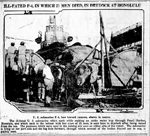 0802359 |
2.34k | FIRST VIEW OF THE F-4 (SS-23) AFTER BEING RAISED FROM HONOLULU HARBOR. The ill-fated U. S. submarine which sank while making an under water trip through Pearl Harbor, Honolulu, and which sank to the bottom with her crew of 21 men, is seen here in drydock after being raised from the sea. The pontoons which were used in the raising are seen on either side of the vessel. The submarine is lying on her port side and the big hole forward, through which several of the bodies floated out to sea, is plainly seen. |
Insert photo courtesy of Darryl L. Baker. Image and text provided by Arizona State Library, Archives and Public Records; Phoenix, AZ & State Historical Society of North Dakota. Photo from Weekly Journal-Miner (Prescott, Ariz.) 1908-1929, 15 September 1915, Image 1 & Bismarck Daily Tribune. (Bismarck, Dakota [N.D.]) 1881-1916, 18 September 1915, Image 6, via chroniclingamerica.loc.gov. | |||
 0802362 |
305k | F-4 (SS-23) in dry dock showing hole. | Photo courtesy of Darryl L. Baker. | |||
 0802362b |
322k | F-4 (SS-23), 28 August 1915. Note the open bow cap. The bow cap was not removed, it is actually still in place, just rotated so that one of the openings for the tubes can be seen. It is curious to note that apparently the salvage crew was rotating the cap while the boat was in drydock. Some pics show it open, some shut. Most likely they wanted to remove torpedoes stored in the tubes for safety reasons. In this case it would have been a lot easier to pull the weapons out of the tubes from outside. With the boat upside down it would have been nearly impossible to pull them out into the torpedo room. |
Text courtesy of David Johnston (USN, retired) Photo courtesy of Darryl L. Baker. |
|||
 0802362c |
335k | Another item to ponder… the deduced cause of the loss has always been listed as leaking battery acid that weakened the hull, causing it to collapse. But, the hull seems to have collapsed from the top down. There is no way for battery acid to affect the hull at the top of the boat. In fact, the hull underneath the forward battery is in great condition! In addition, the collapse seems to have occurred in the torpedo room, forward of the bulkhead, and right in the area at the top of the hull where the operating gear for the bow planes penetrated the hull and close to the area where the torpedo loading hatch was. Theory: undetected corrosion in this area caught up to them on the last dive. |
Text courtesy of David Johnston (USN, retired) Photo courtesy of Darryl L. Baker. |
|||
 0802362a |
299k | Debris taken from F-4 (SS-23). I think there was a number of problems. Yes, the battery tank was leaking and exposing the hull to the acid. The battery tank bilge suction had been plugged by sealing compound giving the crew the impression that the that bilge was dry when infact it was probably full and mostly with sulphuric acid. Sulphuric acid fumes were probably in the air over the batteries and condensed onto the inner hulls. The boat had just come out of the yard in Pearl harbor where she had just been fitted a new design of propellers that were efficient at low speeds but provided little drive at higher RMP's. Couldn't drive herself to the surface. The batteries were highly effected by the high heats and humidities of the Hawaiian climate and could rarely be charged beyond 80% and were susceptible to hydrogen gas explosions. The riveted hull/s of these boats leaked and wept and humid and were often wet inside. I have some photos, yet to be posted, that show the highly corroded hull rivets caused by the acid from the batteries. There was some extreme corrosion shown of these rivets and the hull around them. I will get these posted soon. The only thing I feel is lacking is the knowledge of which way the hull was facing when found. I have a suspicion this happened as the sub was heading out and very soon after she left the harbor. Her automatic blow systems was set up perfectly according to the investigation board that examined the hulk after salvage. All the proper valve settings for surfacing the vessel were completed. She had to have had the hull rupture at depth less than 100 feet, which her auto surfacing systems was set to kick in. I'm sure there are many things we will not know but one thing that we do know is she was known as a bad luck boat, a "Hoo Doo" boat. She was having issues before she was commissioned and Commanding Officer Ede even alluded to this in a letter he wrote to his brother days before the accident. He had said he wouldn't be surprised if it "disappeared in a puff of smoke". The letter arrived after the sub had sunk. |
Text courtesy of Ric Hednan . Photo courtesy of Darryl L. Baker. |
|||
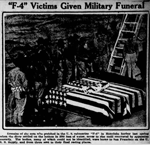 |
121k | F-4 (SS-23) Victims Given Military Funeral. Remains of the men who perished in the U. S. submarine F-4 in Honolulu harbor last spring when the diver settled on the bottom in 300 feet of water, never to rise until recovered by apparatus recently. The bodies, many of which could not be identified, were borne to San Francisco on the Supply, and from there sent to their final resting places. |
Image and text provided by Washington State Library; Olympia, WA. Photo & text by The Tacoma Times.(Tacoma, Wash.) 1903-1949, 29 September 1915, Image 5, courtesy of chroniclingamerica.loc.gov. |
|||
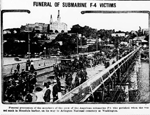 |
NR | FUNERAL OF SUBMARINE F-4 (SS-23) VICTIMS. Funeral procession of the mourners of the crew of the American submarine F-4 who perished when the vessel sank in Honolulu harbor, on its way to Arlington National cemetery at Washington. | Image and text provided by Louisiana State University; Baton Rouge, LA. Photo & text by The Madison Journal.(Tallulah, Madison Parish, La.) 1888-current, 23 October 1915, Image 3, courtesy of chroniclingamerica.loc.gov. |
|||
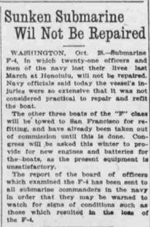 0802365 |
NR | Sunken Submarine Will Not Be Repaired Submarine F-4 (SS-23), in which twenty-one officers and men of the navy lost their lives last March at Honolulu, will not be repaired. Navy officials said today the vessel's injuries were so extensive that it was not considered practical to repair and refit the boat. The other three boats of the "F" class will be towed to San Francisco for refitting, and have already been taken out of commission until this is done. Congress will be asked this winter to provide for new engines and batteries for the boats, as the present equipment is unsatisfactory...... |
Image and text provided by University of Nebraska-Lincoln Libraries, Lincoln, NE. Photo & text by Omaha Daily Bee. (Omaha [Neb.]) 187?-1922, 29 October 1915, Image 2, via chroniclingamerica.loc.gov. | |||
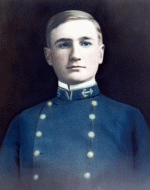 |
23k | Alfred Louis Ede, Lieutenant, Junior Grade (Commanding Officer) of the F-4 (SS-23) at the time of her loss. | USN photo courtesy of oneternalpatrol.com. | |||
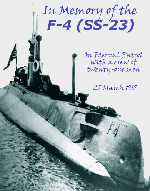 |
43k | Commemorative photo in memory of the F-4 (SS-23). | Photo courtesy of Tom Kermen. | |||
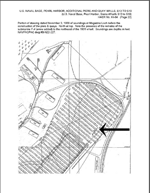 |
376k | While in the Inter-Island Company drydock, F-4 (SS-23) was inspected to determine the cause of her loss, and the bodies of her crew were removed for military burial. Anything useful, including her engines, were stripped from the boat. In September 1915 she was refloated from the dock with the same pontoons and towed into Pearl Harbor a few miles down the coast. She was towed under the pontoons into Magazine Loch until she grounded in the shallow inlet. She sat in this position, peacefully resting in the water until 1940. At that time there were plans afoot for the construction of the Sierra pier and other new facilities for the growing submarine base. It was found that the hulk of the F-4 was in the way. A trench was dredged alongside the wreck and she was rolled into it, thus clearing the way for the pier construction and eliminating her as a collision threat. A 1999 magnetometer survey of the waters near pier Sierra 14 detected a massive object, approximately 80 feet from the pier and buried under at least 20 feet of sediment. This is the F-4, resting in her grave. She is still there to this day. It was reported at one point that the hulk had been pushed up onto the beach for temporary storage, but this report is actually false. | Text courtesy of David Johnston | |||
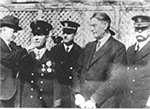 |
263k | President Calvin Coolidge presenting the Medal of Honor to Chief Petty Officer Frank Crilley on 15 February 1929 for his heroism in the rescue of Chief Petty Officer William F. Loughman during salvage operations on the submarine F-4 (SS-23). Left to right: President Coolidge, Chief Crilley, the now-ensign Loughman, Secretary of the Navy Curtis P. Wilbur, and Chief of Naval Operations Charles F. Hughes. | Image scanned from Mud, Muscles and Miracles, by Captain Charles A. Bartholomew, USN and Commander William I. Milwee, Jr., USN (Ret.) via Robert Hurst. | |||
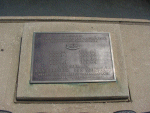 | 91k | Memorial plaque at Independence Seaport Museum, Philadelphia PA, July 2006 for the crews of United States submarines lost during peace time accidents: F-1 (SS-20), F-4 (SS-23), G-2 (SS-27), H-1 (SS-28), O-5 (SS-66), O-9 (SS-70), S-4 (SS-109), S-51 (SS-162), Squalus (SS-192), Scorpion (SSN-589) & Thresher (SSN-593). | Photo courtesy of Wendell Royce McLaughlin Jr. | |||
 |
52k | Commemorative group photo of the crew of the F-4 (SS-23). In Memorium: In the Second Book of Shmuel (Samuel), 22nd chapter, 5th through the 20th verses, translated from the original in Hebrew and published by the Koren Publishers of Jerusalem, Israel, 1982, can perhaps aptly describe the fate of the crew and all other U.S. submariners who died defending their county: "When the waves of death compassed me / the floods of ungodly men made me afraid; / the bonds of She'ol encircled me; / the snares of death took me by surprise; / in my distress I called upon the Lord, / and cried to my G-D: / and he heard my voice out of his temple, / and my cry entered into his ears. / Then the earth shook and trembled; /the foundations of heaven moved / and shook because of his anger /...the heavy mass of waters, and thick clouds of the skies /... And the channels of the sea appeared, / the foundations of the world were laid bare, / at the rebuking of the Lord, at the blast at the breath of his nostrils. / He sent from above, he took me; / he drew me out of many waters; / he delivered me from my strong enemy, and from those who hated me; for they were too strong for me. / They surprised me in the day of my calamity: / but the Lord was my stay / He brought me forth also into a large place: / he delivered me because he delighted in me./" |
Courtesy of oneternalpatrol.com. | |||
View the Skate / F-4 (SS-23)
DANFS history entry located on the Haze Gray & Underway Web Site.
Crew Contact And Reunion Information
Not Applicable to this Vessel
Additional Resources and Web Sites of Interest
On Eternal Patrol
ComSubForPac - USS F-4 (SS-23) 25 March 1915, 21 Drowned
PigBoats.COM TM, a Historic Look at Submarines
| Back To The Main Photo Index | Back To the Submarine Index |
|
Problems and site related matters, E-mail Webmaster |
|
This page is created by Gary Priolo and maintained by Michael Mohl All Pages © 1996 - 2025 NavSource History |